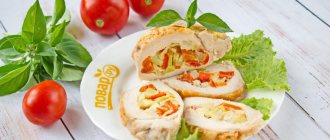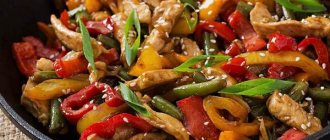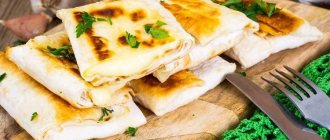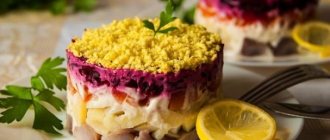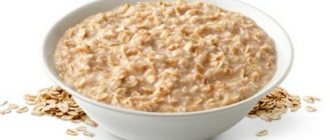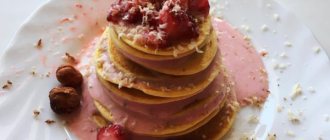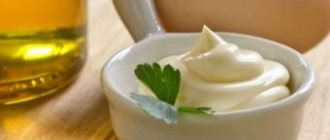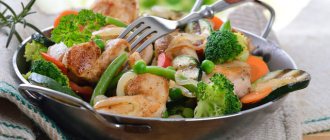With cheese
To serve on a festive table, you can make a dish of baked red fish under a cheese cap with watercress sauce. It is both tasty and healthy.
Diet recipe ingredients:
- Fresh frozen and chilled trout – 1.5 kg.
- Watercress (if it is difficult to find, you can replace it with any greens that you like best) - approximately 5-6 tablespoons, chopped.
- Lightly salted cucumber – 2 pcs. medium size.
- Low-fat sour cream – 300 g.
- Hard cheese, preferably sharp – 250 g.
- Lemon – 1/2 pcs.
- Salt, white ground pepper - to taste.
The KBJU of such baked dietary fish per 100 g is:
- Calorie content – 320 g.
- Proteins – 10.4 g.
- Fats – 6.3 g.
- Carbohydrates – 5.3 g.
To prepare such dietary fish, you must follow the following technology:
- Lay the trout carcass flat, removing the backbone and all rib bones.
- Prepare 2 large pieces of foil.
- Salt the trout on both sides, sprinkle heavily with lemon juice and pepper.
- Place the fillet in foil.
- Grate the cheese on a fine grater and mix with 100 g of sour cream. Apply the resulting mixture to the top of the fish.
- Raise the edges of the foil so that it does not cover the trout on top, otherwise the cheese and sour cream will be smeared.
- Place in the oven, which has been preheated to 180°C, and bake for approximately 20 minutes. It is necessary to monitor the fish so that the sour cream and cheese crust does not burn.
- To prepare the sauce for serving fish, you need to finely grate the lightly salted cucumber and mix it with the remaining sour cream.
- Wash watercress or any other greens, dry thoroughly and chop very finely. Add to sour cream, salt and pepper the mixture and stir everything vigorously to evenly distribute the ingredients.
- Dietary fish is served directly in foil - it is cut into portions, and the sauce is served in a separate sauce boat.
Which variety to choose for your diet: tuna, pangasius, pike, pike perch, tilapia
Today there are a large number of varieties of edible fish available, but those losing weight need to choose a product with moderate calorie content.
What kind of fish is best to cook for a diet:
- Tuna: 100 grams of product contains no more than 5 grams of fat. The carbohydrate content is minimal. The fish is enriched with zinc, iron and copper. Whether or not to include tuna in your diet is up to you, because if you don’t like the taste of the dish, it will not benefit your body. Energy value – 139 calories.
- Pangasius: also refers to low-fat fish varieties. If pangasius is not available, it can be replaced with hake or pollock. This fish can be included in a therapeutic diet for gastrointestinal diseases, since it is quickly absorbed by the body.
- Pike: 100 grams of the product contains less than 2 grams of fat, so pike is considered an ideal option for the diet. 100 grams contain only 84 calories.
- Pike perch: refers to varieties characterized by minimal fat content. It is considered one of the most useful freshwater fish.
- Tilapia: allowed to be eaten by those losing weight due to its moderate calorie content and fat content. 100 grams of fish contain 2-5 grams of fat. The product has a delicate taste and is easy to heat treat.
On the diet you can also eat sea bass, navaga, cod, pollock, and carp.
Be sure to check out: Diet cabbage salad: the best recipes Safe cleansing: flax seeds for weight loss Kefir on a diet: are alternatives possible Proper castling: how to replace high-calorie treats and allergenic foods on a diet
With zucchini
There are different halibut dishes - dietary ones include halibut stewed with carrots and zucchini. It will require the following components:
- Halibut fillet – 400 g.
- Lemon – 1/2 pcs.
- Carrots – 1 root vegetable.
- Zucchini or zucchini – 1 pc. medium size.
- Onions – 1 pc.
- Low-fat cream – 100 ml.
- Dry white wine – 50 ml.
- Flour – 1/2 tbsp.
- Salt, black pepper - to taste.
- Lean oil, preferably extra virgin olive oil 2-3 tbsp.
KBJU of such dietary halibut per 100 g:
- Calorie content – 198 g.
- Proteins – 7.3 g.
- Fats – 5.2 g.
- Carbohydrates – 3 g.
The cooking process consists of the following sequence of actions:
- Cut the halibut into small pieces, season with salt and pepper and leave in the refrigerator while you prepare the next ingredients.
- Peel the carrots and cut them into half slices quite thinly.
- Chop the onion into thin half rings.
- Cut the zucchini into small slices.
- Heat vegetable fat in a frying pan, first cook the onion in it until transparent, then add it with other vegetables. The process of proper stewing in this case should take no more than 2-3 minutes, so that the vegetables do not end up becoming too soft in the final dish.
- Then add the fish here and close the lid. The intensity of the fire should be minimal.
- While the fish is stewing, dilute the flour in 2-3 tablespoons of cream. Achieve such a condition that there are no lumps. Then pour the rest of the cream into the mixture and stir vigorously again.
- Then pour the cream into the fish in a thin stream. Stir lightly and continue simmering.
- The total time for heat treatment of fish should not exceed 25 minutes.
Salmon with bell pepper
©goodhealthy_food
Ingredients:
- salmon (steak) – 1 pc.
- onion – 1 pc.
- carrots – 1 pc.
- bell pepper – 1 pc.
- spices
- greenery
- lemon juice (optional)
How to cook?
- Wash the fish and rub with spices and finely chopped herbs.
- Cut the onion into cubes, and the bell pepper and carrots into strips.
- Make a “boat” out of food foil. First place the vegetables there, and then the salmon steak, pour lemon juice over all the ingredients and cover the boat tightly with foil.
- Bake dietary fish with vegetables for about 20-25 minutes at 200 degrees.
Cutlets
To prepare dietary baked cutlets, you need to spend very little time, and the result will exceed all expectations. For the recipe you will need:
- Berex or hake – 1 kg.
- Crumb of white bread – 100 g. + milk 2 tbsp. to soften bread.
- Salt and ground pepper - to taste.
- Onion – 1 small head.
- Garlic – 2 cloves.
- Pork – 160 g.
- Chicken egg – 1 pc.
KBZHU in 100 g of dietary fish cutlets:
- Calorie content – 238 g.
- Proteins – 6.3 g.
- Fats – 5.2 g.
- Carbohydrates – 3.1 g.
Step-by-step recipe for diet cutlets:
- Divide the fish into halves, remove the bones and grind it together with the pork in a meat grinder.
- Send the onions there too. Add it to the minced fish, salt and pepper. Mix everything vigorously.
- Pour milk over the bread crumb and let stand for 2 minutes.
- Beat the egg into the minced meat, add white bread crumbled by hand. Mix the minced meat again.
- Prepare a baking sheet by lining it with parchment paper. Gently form the cutlets with your hands - you don’t need to roll them in anything, as they won’t fry.
- Place them on parchment and place the baking sheet in the oven. Cook them for 20 minutes.
- To ensure they turn out delicious, you should periodically look into the oven to make sure they don’t burn. If the cutlets begin to brown too quickly on top or bottom, you can grease them with a small amount of vegetable oil using a silicone pastry brush. This procedure will keep them juicy from the inside.
The benefits of dietary fish dishes
From childhood, people are taught a healthy habit - eating river and sea food at least once a week. The fact is that they contribute to the saturation of the body, its normal development, burning of fat mass and strengthening muscle mass. Fish is called one of the most valuable sources of healthy fatty acids, and this is not the whole benefit of the product.
- Protein content. River and sea products contain a large amount of protein: depending on its type, it can reach 25 grams per 100 grams of product. However, such protein is very different from meat: it is absorbed several times faster. If beef or pork protein is broken down by the body into valuable substances within 5 hours, then fish protein requires only 2 hours of intensive work of the body. Thus, the load on the digestive system is much lower when consuming fish.
- Omega-3 fatty acids. Consumption of saturated fatty acids is essential for humans. They promote the proper functioning of the cardiovascular system, strengthen women's health, and prevent the development of atherosclerosis. In addition, Omega-3 can relieve or minimize stress, positively affecting brain function. With the help of fatty acids, you can also solve problems with metabolism that has slowed down.
- Complex of vitamins. Dietary stewed or baked fish retains all the vitamins that were provided by nature in raw meat. Vitamins A, D, as well as minerals: calcium, iodine and phosphorus - all this helps the body to be strong, work properly and be healthy. Consumption for weight loss should occur at least four times a week. With one-time consumption there is a risk of not detecting the effect.
However, not every river or sea animal is useful for weight loss and contributes to it. There are a number of conditions under which sea and river gifts become harmful and pose obstacles to achieving the cherished goal. And sometimes an incorrectly selected product can harm human health.
In Volga style
Carp stuffed with buckwheat, Volga style, is an excellent option to get a full, delicious dinner while maintaining the principles of proper nutrition. For the recipe you need to prepare the following components:
- Carp – 2 medium-sized pieces.
- Dry buckwheat – 1/2 cup.
- Onion - 2 large heads.
- Sour cream – 200 g.
- Breadcrumbs for breading.
- Salt and ground black pepper - to taste.
- Vegetable oil - for lubrication.
KBJU of such dietary carp per 100 g:
- Calorie content – 248 g.
- Proteins – 4.9 g.
- Fats – 4.6 g.
- Carbohydrates – 9.4 g.
Step-by-step process for preparing PP dishes:
- Clean the carp from scales, gut them and wash them inside and out. Be sure to remove the gills from the fish.
- Fry buckwheat in a hot frying pan for 2 minutes. It is necessary to stir it all the time so that it does not burn.
- Then boil 200 ml of water, add the cereal, lightly salt and cook the porridge until the water is completely absorbed by the buckwheat. It is important that it turns out slightly dense and undercooked.
- Cut the onion into half rings and fry it in vegetable oil until light golden brown.
- Then you need to mix it with buckwheat and add about half of the sour cream to this mixture. Stir vigorously and stuff the belly of the carp with this mixture.
- Top the fish with salt, grate with pepper, grease with the rest of the sour cream and roll in breadcrumbs.
- Place on parchment, fold its edges over the top, securing it over the fish and place in the oven for approximately 25-35 minutes at 200°C.
- Periodically look in and check the condition of dietary fish.
With champignons
You can bake red fish with mushrooms deliciously. Champignons are best suited for this, the taste of which goes perfectly with salmon or trout.
Diet recipe components:
- Trout, salmon, chinook salmon or any other red fatty fish - 600 g.
- Champignons – 500 g.
- Onions – 2 pieces.
- Dill – 1 bunch.
- Olive oil – 2 tbsp.
KBZHU of such dietary fish with champignons per 100 g will be:
- Calorie content – 230 g.
- Proteins – 8.4 g.
- Fats – 6.3 g.
- Carbohydrates – 3 g.
Cooking process:
- Red fish must be filleted and cut into portions.
- Heat olive oil in a frying pan and fry the onion cut into half rings.
- Wash the mushrooms, peel them, cut into quarters. Add to the onion and simmer for approximately 5-7 minutes.
- When they have reduced to approximately half their original volume and the liquid has evaporated slightly, fish can be added to the fried component. It is laid out in pieces, slightly mixed, but without allowing the fish to separate into smaller pieces, close the pan with a lid.
- Cook for approximately 20 minutes over low heat. This stewed dietary red fish is ideal for a full dinner - it is nutritious due to its high protein content, but not high in calories. In addition, the saturation process will last a long time, since mushrooms are digested quite slowly by the body.
Adviсe
Every chef and experienced housewife has her own secrets. By using them, you will simplify and speed up the process, and also make the dish even more tasty and juicy.
Basic recommendations:
- The most suitable seasonings for fish are bay leaf, ground nutmeg, cumin, coriander, chopped garlic, cloves, fresh ginger, basil, oregano, mint, dill, parsley.
- Do not salt the fish in advance - it will lose its juices. Seasonings and salt should be added right before baking. Marinating the product does not apply to this situation.
- To ensure that fish retains its taste and maximum amount of substances when fried, it is breaded. Both regular flour and special breadcrumbs will do.
- Fish should not be boiled over high heat. Cook it over low heat, avoiding excessive bubbling and boiling of the broth.
- Frozen fish is not favored by experienced cooks. When defrosted in water it becomes dry, in the microwave it becomes loose. Therefore, if you purchased a frozen product, wait until it thaws naturally on the top shelf of the refrigerator. This way the texture will be preserved best.
- Before preparing the dish, soak the fish in milk. 40-60 minutes is enough to remove the pungent smell of fish.
In tomato sauce
You can cook delicious mackerel baked in tomato sauce. For this, it is best to take mackerel, since its specific fatty taste is somewhat neutralized by the taste of the tomato, which makes the fish even more tasty.
PP recipe ingredients:
- Mackerel – 2 pcs. medium size
- Onions – 2 heads.
- Dill – 1 bunch.
- Tomato paste – 4-5 tbsp.
- Vegetable oil – 2 tbsp.
KBZHU of such dietary baked mackerel in tomato per 100 g:
- Calorie content – 196 g.
- Proteins – 4.3 g.
- Fats – 5.2 g.
- Carbohydrates – 2.3 g.
Step-by-step dietary recipe:
- The mackerel must be thawed, gutted, the head cut off, filleted and the spine and costal bones removed.
- Cut into portions and set aside.
- Heat vegetable oil in a frying pan and fry the onion, cut into half rings or cubes. Add tomato paste and finely chopped dill. Salt and pepper everything.
- Place the fish on the fried onion in the tomato, add 2 tablespoons of water, stir lightly so as not to break the mackerel.
- Cover with a lid and simmer for 20 minutes until fully cooked.
With broccoli in your sleeve
By baking sea bass or hake with vegetables, you can get a complete dish that is suitable for dietary nutrition. If you use broccoli and low-fat fish for this, the number of calories will be minimal.
Diet recipe ingredients:
- White sea fish fillet – 600 g.
- Broccoli – 500 g.
- Onion – 1 piece.
- Sour cream – 100 g.
- Lemon – 1/2 piece.
- Dill – 1 bunch.
- Salt and ground black pepper - to taste.
- Butter – 40 g.
The KBJU of such baked fish with broccoli per 100 g is:
- Calorie content – 140 g.
- Proteins – 6.1 g.
- Fats – 3.3 g.
- Carbohydrates – 4 g.
Step by step recipe:
- Fillet the fish and cut into portions.
- Break the broccoli into small florets. They need to be boiled for 3-4 minutes in lightly salted water.
- Cut the onion into small slices. Mix together with boiled broccoli. Add salt, add sour cream and stir vigorously.
- Prepare the sleeve. Put vegetables in sour cream in it. Add here the pieces of fish that were previously sprinkled with lemon. Place the butter cut into pieces.
- Wrap the bag tightly and shake lightly to combine the ingredients.
- Place in the oven to bake for approximately 20 minutes. The temperature should be about 200°C.
What kind of fish can you eat while losing weight?
The most dietary varieties are white, low-fat species: pike, cod. It is included in the diet for weight loss more often than fatty sea varieties. Salmon, trout or pink salmon contain more fatty acids that speed up metabolism, so they are also allowed to be included in the diet for weight loss. Smoked and fried will not work, but stewed or boiled will be ideal for weight loss.
On a diet, it is allowed to eat up to 800 grams of fish per day, so as not to burden the kidneys and liver. It is better to combine it with vegetables, white poultry, egg whites and low-fat dairy products. To lose weight you need to choose the right fish meat:
- frozen fillet - best from a safety point of view, but could lose some of the vitamins;
- fresh carcass - you should buy from trusted traders; the meat should be elastic and the fish eyes should be clear;
Low-fat varieties
The lowest calorie fish is included in the group of river or lean marine species. These include bream, pike, and river perch. Suitable marine varieties include pollock, hake, flounder, cod, and navaga. The approximate calorie content is 70-100 kcal, and there is only 4% fat. Varieties with medium fat content up to 8% and 100-140 calories per 100 grams include pink salmon, low-fat herring, catfish, pike perch, and catfish. It is useful to include trout, carp, horse mackerel, tuna and sea bass in your diet for weight loss.
Fat sea fish
Fish from cold seas boasts a calorie content of 200-250 kcal per 100 grams. This group of fatty varieties includes eel, mackerel, halibut, sturgeon, and any red fish. They are characterized by a high content of healthy fatty acids, but should not be included in the daily diet - they do not contribute to weight loss. It is better to combine low-fat varieties to stimulate metabolism and lose weight.
Mackerel with lemon and herbs
To follow a diet and proper nutrition, the following recipe option is suitable, for which you need to prepare the following ingredients:
- Mackerel – 2 pcs.
- Onions – 4 heads.
- Lemon – 1 pc.
- Dill – 1 large bunch.
- Salt and ground black pepper - to taste.
- Mustard – 1 tsp.
- Vegetable oil for greasing the mold and fish.
KBZHU baked mackerel:
- Calorie content – 228 g.
- Proteins – 6.7 g.
- Fats – 4 g.
- Carbohydrates – 3.1 g.
Cooking process:
- The mackerel must be gutted, washed inside and out and placed in a rectangular dish that has been previously greased with vegetable oil. The fish must be placed belly up, having previously been lubricated with lean fat.
- Cut half a lemon into thin slices.
- Squeeze the juice from the second half of the lemon and sprinkle it over the inner cavity of the fish's abdomen.
- Lubricate the outer and inner parts of the mackerel with mustard.
- Chop the onion into small cubes. And stuff the abdominal cavity of the fish with it.
- Cover the top with a sheet of foil and place in the oven for 25 minutes.
- 10 minutes before the end of cooking, the foil can be removed so that the resulting liquid evaporates slightly.
Seabass baked in the oven
Ingredients:
- – sea bass – 2 pcs.,
- – green onion – 1 pc.,
- – parsley – a few sprigs,
- – cilantro (dill) – several sprigs,
- – Himalayan salt – to taste,
- – seasoning for fish – to taste,
- – onion – 1 pc.,
- – lemon – a couple of slices.
Number of servings – 2\ Cooking time 40 minutes.
How to cook at home
- Clean the fish from scales, carefully remove the insides so as not to crush the bile, do not forget to remove the gills. Rinse the fish thoroughly under running water and dry with paper towels.
- Sprinkle the carcasses with fish seasoning, lightly salt them with pink Himalayan salt or sea salt, and leave for a few minutes so that the fish is saturated with the aromas of the seasoning.
- Place a green onion, parsley, cilantro or dill into the belly of each fish. Also add a couple of slices of lemon or lime.
- Line a baking dish with foil. Cut the onions into half rings and sprinkle them on foil. This will not only make the fish more aromatic and tastier, but will also prevent the skin of the fish from sticking to the foil and can be easily removed from the baking sheet.
- Place sea bass with herbs on top of the onion, bake in an oven preheated to 180 degrees for 20-25 minutes in top and bottom heating mode.
- Prepare a healthy vegetable salad and serve along with baked sea bass. A tasty, low-calorie and very healthy dish.
Carp stuffed with rice
To prepare a diet-friendly recipe, you can bake carp stuffed with rice and mushrooms. For this dietary recipe you will need the following ingredients:
- Mirror carp – 1 large piece.
- Rice - 1/3 cup dry cereal.
- Oyster mushrooms or champignons – 200 g
- Onion – 1 head.
- Garlic – 2 cloves.
- Vegetable oil – 2 tbsp.
- Salt, white ground pepper - to taste.
KBZHU of such carp per 100 g:
- Calorie content – 268 g.
- Proteins – 7.2 g.
- Fats – 4 g.
- Carbohydrates – 7 g.
Process of preparing PP recipe:
- Gut the carp, remove the gills and remove scales.
- Lightly boil the rice in salted water. It should be half cooked.
- Fry chopped onion and garlic in vegetable oil, then add mushrooms and simmer until their volume is reduced by half.
- Grease the top of the carp with a small amount of lean fat, add salt and pepper.
- Stuff the belly with the resulting mixture. Place carefully on foil or parchment, wrap tightly and place in the oven for 30 minutes to cook.
How to cook dietary fish
Proper low-calorie preparation of fish species involves processing without oil and smoking. The easiest way is to boil fillets or carcasses in water, make broth, and use it for soup. If you have a multicooker or double boiler, you can steam it, stew it with vegetables and spices. For dinner, you can bake the fillet in the oven under foil or fry it in a grill pan without oil.
Boiled
A simple meal option would be boiled fish, which contains a minimum amount of calories. To make it, take a large carcass, remove scales, gills and internal organs. Place the chopped pieces in a saucepan with roots (parsley, celery, carrots are suitable) and spices (cinnamon, cloves, black pepper, dill). Cook until done and eat chilled.
- Pork soup: delicious recipes
- Anaerobic load - what is it. Anaerobic workouts for weight loss and fat burning with video
- Baked apples in the microwave: recipes
For a couple
Low-fat steamed fish in a slow cooker for weight loss turns out very tasty. For production, it is better to take large pieces, and to create steam, use vegetable broth with herbs. Place the pieces on the multicooker rack, after pouring aromatic water into the bowl. Set the “Steam” mode and cook for about half an hour until the meat changes color. The dish can be eaten cold or hot.
In the oven
An evening meal option would be oven-baked fish for weight loss. Medium or high-fat varieties are suitable for baking, and when using low-fat ones, they should be accompanied by a small amount of olive oil or butter for softness. Place the pieces on a baking sheet or in a mold, wrap in foil, pour over a light lemon and basil sauce, bake for half an hour at 190-200 degrees.
Stewed fish in a slow cooker
If you want to quickly prepare a delicious dish that is piquant but retains maximum benefits, you should use the recipe for monkfish in spicy sauce.
Components:
- Monkfish – 1.5 kg
- Onion – 2 pcs.
- Tomatoes – 6 pcs.
- Garlic – 5 cloves.
- Ginger – 3 cm root.
- Chili pepper - to taste.
- Natural yogurt – 150 ml.
- Vegetable oil – 3 tbsp.
- Turmeric, coriander - 1 teaspoon each.
- Sugar – 1 tbsp.
- Salt – 1/2 tbsp.
KBJU:
- Calorie content – 208 g.
- Proteins – 6.3 g.
- Fats – 5 g.
- Carbohydrates – 3 g.
Recipe:
- Fillet the fish and cut into small pieces.
- Place in the multicooker bowl.
- In a frying pan, fry the onion, garlic and grated ginger root in vegetable oil. Add turmeric, coriander, natural yogurt, finely chopped hot chili pepper, sugar, salt. Mix everything vigorously and place on top of the fish.
- Pour boiling water over the tomatoes, peel them and cut the pulp into small cubes. Add to the multicooker bowl, close the lid and cook for 30 minutes.
Capelin in the oven
Ingredients:
- – capelin – 300 gr.;
- – onion – 1 pc.;
- – whole grain flour – 4 tbsp;
- – soy sauce – 40 ml;
- – mustard – to taste;
- – wine vinegar or lemon juice – 1 tbsp;
- – ground black pepper – 2 pinches.
How to cook at home
- The first step is to let the capelin defrost, then be sure to clean it thoroughly - remove the head, entrails, and be sure to remove the black film that is present inside each fish. Rinse the cleaned capelin a little, dry it and put it in a plate.
- Prepare the marinade - combine soy sauce with a small amount of mustard (to taste), add lemon juice or wine vinegar - just a couple of drops. Pour the marinade over the fish and sprinkle with ground pepper. Leave the capelin alone for half an hour.
- After preparing a heat-resistant form, cover the bottom with onions - first peel the onions, rinse, cut into half rings. Preheat the oven to 170 degrees.
- Roll capelin in whole grain flour.
- If desired, so as not to stain your hands, you can put the flour in a bag, throw all the capelin in there, and mix everything several times.
- Place the capelin on top of the onion bed. Bake the capelin for about 15-17 minutes. Afterwards, serve the capelin to the table - either with vegetables or with baked potatoes.
- Bon appetit!
Paste
Dietary fish dishes can have different looks and shapes. It's worth trying fish paste once, which you can spread on toasted pieces of toast, to fall in love with this recipe.
For it you need to take the following components:
- Hake – 500 g.
- Onion – 1 head.
- Butter – 3 tbsp. in melted form.
- Dill – 1 small bunch.
KBJU of this pate per 100 g:
- Calorie content – 178 g.
- Proteins – 4.1 g.
- Fats – 3.2 g.
- Carbohydrates – 1.5 g.
Cooking process:
- Boil the hake, cool it, remove the bones.
- Wash the dill, dry it with paper towels, and chop it very finely.
- Fry the onion, chopped into small cubes, in butter.
- Combine all ingredients in one blender bowl and grind into a paste. Add salt, add pepper to taste, stir thoroughly, fold the mold and, closing it tightly with a lid, put it in the refrigerator for 2 hours so that the mass thickens a little.
Shawarma
For this recipe you need to prepare the following components:
- Lavash – 1 sheet.
- Stewed red fish - 2 large steaks.
- Lettuce leaves – 5 leaves.
- Sour cream – 2 tbsp.
- Tomatoes – 1 pc.
- Finely grated cheese – 1/2 cup.
KBJU of fish shawarma in 100 g:
- Calorie content – 261 g.
- Proteins – 4.3 g.
- Fats – 5.2 g.
- Carbohydrates – 8 g.
Step by step process:
- Simmer the fish until fully cooked in lightly salted water. Cool and remove bones.
- Place the lavash on the table. Place washed lettuce leaves on one side.
- Pour boiling water over the tomato, remove the skin and cut into halves. Place on top of lettuce leaves. Top with warm fish.
- Grate the cheese and mix it with sour cream. Distribute the sauce over the filling and carefully wrap the pita bread, forming a shawarma.
- Brush the top with either sour cream or softened butter. Place in the oven to bake for 5-10 minutes until the cheese has melted and a golden brown crust has formed on the pita bread.
Bon appetit! Rating of healthy fish by availability
- Mackerel . First place among oily fish. Leader in vitamins: group B; minerals: potassium, calcium and phosphorus.
- Herring . One of the most iodine fish. Eating two or three pieces of lightly salted herring every day can provide a supply of vitamins and minerals, plus, what is important, is the prevention of clean blood vessels from cholesterol plaques.
- Trout . Although the fish is not from the sea, it is still healthy.
- Carp. The pulp is dry, but it contains useful elements. You need to eat carp for healthy skin, nerves and proper digestion.
Diet salad
Fish served in salad form can be beneficial. Moreover, such a dish will be an ideal full breakfast. To do this, it is enough to simply pre-bake the cod or hake and then you will only have to spend 10 minutes on cooking.
Ingredients:
- Baked fish fillet – 600 g.
- Chicken eggs – 4 pcs.
- White loaf or bread - 4 large pieces.
- Any lettuce leaves - 1 large bunch.
- Olive oil – 3 tbsp.
- Apple cider vinegar – 1 tbsp
- Dijon mustard – 1 tsp.
- Salt to taste.
These ingredients make 4 servings of dietary salad.
The KBJU of such a salad for 1 serving is:
- Calorie content – 140 g.
- Proteins – 6.7 g.
- Fats – 1.3 g.
- Carbohydrates – 2 g.
Step-by-step cooking process:
- The fish must be baked in the oven. If it is a fillet, then it is sent immediately in parchment or foil to the oven; if it is whole carcasses, they must first be gutted.
- After the fish is baked, you need to divide it into small pieces, removing all the bones along the way.
- The salad can be served either hot or cold.
- Cut the white bread into small cubes, lightly sprinkle with half the vegetable oil and place in the oven after the fish for 5-10 minutes to get crispy croutons.
- Wash the lettuce leaves and tear them with your hands. Divide among 4 plates.
- Mix mustard, vinegar and remaining olive oil, add salt. Gently drizzle the oil over the greens and add cubes of croutons (crackers). Arrange the fish pieces.
- Boil water in a saucepan and very carefully beat in the eggs, one at a time. This cooking method is called poached eggs. They cook for exactly 60-80 seconds. They will be slightly runny inside. You need to catch them with a slotted spoon and immediately carefully place them on a serving plate on top of the greens with fish in which the salad will be served.
- Drizzle the rest of the butter-mustard mixture over the top.
The egg is broken when tasting the salad and the yolk serves as part of the sauce.
Baked diet cod with lemon juice and herbs
Dietary fish is useful. The recipes for preparing it are not complicated and do not take much time. Try making baked cod with lemon juice and herbs. As a side dish, you can offer baked grilled or boiled vegetables, as well as a green salad.
To prepare you will need:
- Cod (loin) – 320 g.
- Finely chopped parsley.
- Bulb.
- Juice of half a lemon.
- Salt.
- A little pink pepper.
- Ground white pepper.
Fish fillets should be washed and dried with paper towels. Next it should be cut. Chop the onion. Cut squares out of foil, place an onion in the center of each of them, and pieces of cod on top.
Each individual portion should be salted, pepper and parsley added, and fresh lemon juice should be poured over it. Then we roll all the pieces into envelopes, put them on a baking sheet and put them in the oven, which we preheat to 220 degrees. Bake the fillet for about half an hour. So the dietary fish is ready in the oven. It is healthy and very tasty!
Souffle
This version of fish mousse is perfect for serving on a holiday or everyday table as a cold appetizer. Thanks to corn and green peas, the taste is very original. But to prepare such a recipe, you will have to spend some time.
Ingredients:
- Bereks (red sea bass) – 2-3 pcs. total weight of at least 1.4 kg.
- Canned or frozen corn – 70 g.
- Fresh green peas – 100 g.
- Lemon – 1 pc.
- Gelatin – 15 g.
- Heavy cream for whipping – 200 ml.
- Salt, white or black pepper - to taste.
The KBJU of such dietary fish mousse per 100 g is:
- Calorie content – 231 g.
- Proteins – 6.2 g.
- Fats – 5.3 g.
- Carbohydrates – 2.7 g.
Cooking process:
- Clean the fish, gut it and cook over low heat for 10 minutes.
- At the same time, soak the gelatin in a small amount of cold water.
- When the fish is cooked, you need to remove the bones from it. Do not discard the resulting broth. Place the meat in a blender bowl, and first adding 4/5 of the volume of cream, beat into a homogeneous mass. Squeeze the juice from the citrus fruit and stir.
- If the consistency is too thick, you can add a little fish broth.
- Transfer the resulting mass into a separate bowl.
- Boil green peas. Drain the can of corn.
- Pour the soaked gelatin into the rest of the cream and heat until completely dissolved. It is advisable not to allow the boiling process.
- Pour the resulting mixture into the fish mousse, add green peas and corn. Add salt, pepper, and mix everything vigorously.
- Prepare a form in which the mousse will cool in the refrigerator. To do this, it is advisable to cover it with cling film. Spread the mousse and cover the top with the edges of the film.
- Place in the refrigerator for at least 2 hours or until the mixture is smooth, dense and fairly set.
- Before serving, carefully lay out the mousse along with the film, then remove it and serve, cutting into portions.
For a couple
Steaming dietary fish is the easiest way. It is enough just to marinate it so that it turns out to be piquant in taste. Here are the components you will need to prepare to implement this recipe:
- Salmon fillet – 500 g.
- Mustard – 1 tsp.
- Apple cider vinegar or white wine - 2 tbsp.
- Salt and freshly ground white pepper - to taste.
- Soy sauce – 2 tbsp.
KBJU of steamed red fish:
- Calorie content – 221 kcal.
- Proteins – 9.3 g.
- Fats – 5 g.
- Carbohydrates – 0.3 g.
Cooking method:
- Mix all the ingredients for the marianade.
- Coat the fish with it on all sides and let it stand in the refrigerator for at least 3 hours.
- Then remove the fillet and place it entirely in the multicooker bowl.
- Set the timer for 30 minutes.
These recipes will allow you to get the maximum benefit from fish and adhere to proper nutrition and maintain low calorie content. Many of the dishes presented can be successfully served on a festive table - it is only important to think about how best to serve; photos depicting ready-made recipes can help with this.
The best cooking method: which fish is the healthiest
To get the maximum benefit from the dish, you need to understand how to deliciously cook the selected fish for your diet.
Boiled
Boiling is the best way to prepare fish for consumption when losing weight. The technology allows us to avoid adding oil to dishes, which makes food more nutritious. During cooking, you can add a little lemon juice to the water to make the fish tasty.
Stewed
You can cook it in a slow cooker with the addition of vegetables, herbs, and spices. Braising allows you to preserve the taste of fish, preserving the nutrients in the product.
Baked in the oven
Baking fish in a sleeve or foil will help make the dish juicy and tasty. The product can be baked separately or together with vegetables.
For a couple
You can steam fish without adding oil. This type of heat treatment is suitable for any type of fish. To prevent the product from losing its shape and falling apart, it needs to be slightly acidified and salted before cooking.
Fried
If you eat diet food, avoid fish fried in oil, regardless of its type. This cooking method makes the dish more high in calories and harder on the gastrointestinal tract. Also, do not fry fish in batter: flour, breadcrumbs. This batter is not suitable for a diet. A better alternative to frying in oil is grilling.
